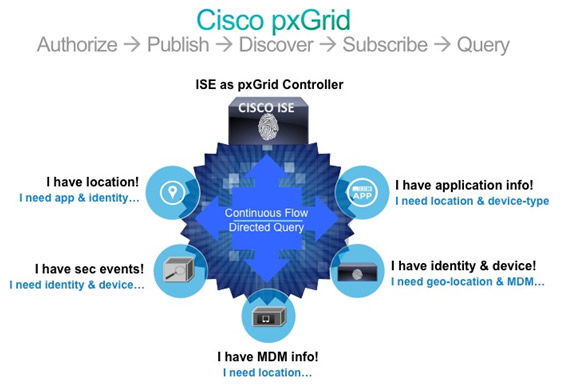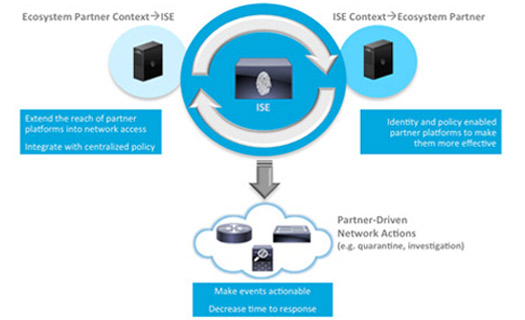What is Cisco pxGrid?
The Cisco Platform Exchange Grid (pxGrid) allows you to integrate your application into the pxGrid, a multivendor, cross-platform network system that pulls together different parts of an IT infrastructure such as security monitoring and detection systems, network policy platforms, asset and configuration management, identity and access management platforms, to name a few.
When you have new business or operational needs arise, you can use pxGrid to exchange context with Cisco products, such as the Cisco Identity Service Engine (ISE), or any other Cisco partner that supports pxGrid.
Cisco pxGrid will provide you with an API that will open up a unified framework that will enable you to integrate to pxGrid once, then share context with any other platform that supports pxGrid. This hub and spoke architecture means that you integrate once to pxGrid and there is no need for you to adopt a host of individual, platform-specific APIs.

The key features of Cisco pxGrid include:
- Context Sharing Control - Because pxGrid is customizable, your can “publish” only the specific information (context) that you want to share and you can control which other pxGrid partner platforms that it gets shared with.
- Bidirectional context sharing – pxGrid enables partner platforms such as yours and others to either publish context or to subscribe to context; you orchestrate and secure what is published and what is subscribed through the pxGrid controller which resides on Cisco Identity Service Engine (ISE).
- Share context data in native formats – you share contextual information in pxGrid using the native data format of your platform - pxGrid does the rest.
- Connect to multiple platforms simultaneously – pxGrid enables you to publish only the context data that is relevant to pxGrid partner subscribers. You can customize numerous context “topics” for a variety of partner platforms, yet always shared via the same reusable pxGrid framework. By sharing only relevant data both publishing and subscribing platforms are able to scale by eliminating irrelevant data.
- Comprehensive SDK – The SDK for pxGrid contains tutorials, sample code, client libraries (in Java and C), sample data output, testing guides, testing resources and tools, as well as release notes; everything that you need to get started.
- Cisco platform support – Cisco Identity Services Engine (ISE) is the first Cisco platform to implement pxGrid, you should look to see more Cisco security platforms supporting pxGrid throughout 2015. And you can start to support pxGrid at any time.
pxGrid in Use
Below is an example how you might use pxGrid to integrate your application into the Cisco Identity Services Engine.

In the diagram above,
- Cisco ISE is being used to share user & device context with your application (shown as DevNet Partner) and thus your application is aware of both the users and devices on the network.
- Cisco ISE is receiving context from your application for implementation of the ISE network policy.
- Cisco ISE is enabling your application to quarantine users and devices in response to threating network events.
- Your application has seamlessly extended its reach into the network.